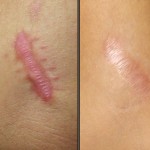Topical scar therapy is an important matter to consider if you’re thinking about having surgery and want to get your best scar.
By Carolynn Grimes
The Plastic Surgery Channel
No matter how big or how small, scars can have a physical and emotional impact on a patient. Dr. Bruce Van Natta, a board certified plastic surgeon in Indianapolis says, “When it comes to scars almost everyone has some concern about scars if they’re undergoing surgery.” The good news is, breakthroughs in new technology and topical ointments can help improve healing and minimize the appearance of scars.
Surgeons say silicone is effective for treating scars
Dr. Van Na
Most common are topical gels or ointments with silicone that can be placed directly on a scar and rubbed into the skin. The topical silicone therapy combined with a daily sun block can be very effective, says Dr. Caroline Glicksman, a board certified plastic surgeon in New Jersey. Glicksman adds, “No scar therapy or scar gel is going to work if the patient doesn’t actually use it.”
Patient compliance is the key for getting the best result
Board certified plastic surgeon, Dr. William P. Adams Jr. MD agrees and says sometimes patients are given silicone strips or bandages that are harder to keep on, stay in place and can even cause a rash, especially in the summer months when it’s hotter. He says with a silicone topical gel the patient can manage their scar treatment easier. “As surgeons, we want to make scar therapy as convenient and practical as possible so the patient will have the best result,” says Adams. He says in his practice, a silicone topical gel is always the first line of treatment when dealing with scars.
Scientific studies have shown that the primary mechanism of action for silicone based scar therapy is skin hydration which leads to less “scar forming” cells and ultimately a better appearing scar.
Van Natta agrees and says patient compliance is extremely important but patients also need to give their body time to fully heal. The color and texture of a new scar will most often improve over time.